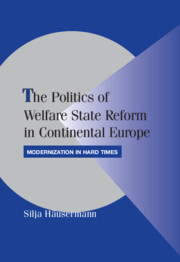Book contents
- Frontmatter
- Contents
- List of Figures
- List of Tables
- Preface
- The Politics of Welfare State Reform in Continental Europe
- 1 “EPPUR SI MUOVE”: WELFARE STATE CHANGE DESPITE INSTITUTIONAL INERTIA
- 2 MODERNIZATION IN HARD TIMES: THE POST-INDUSTRIAL POLITICS OF CONTINENTAL WELFARE STATE REFORM
- Part I Pension Reform in Continental Europe: A Framework of Analysis
- Part II Determinants of Successful Pension Reform in Continental Europe
- Appendices
- References
- Index
- Cambridge Studies in Comparative Politics
Preface
Published online by Cambridge University Press: 06 July 2010
- Frontmatter
- Contents
- List of Figures
- List of Tables
- Preface
- The Politics of Welfare State Reform in Continental Europe
- 1 “EPPUR SI MUOVE”: WELFARE STATE CHANGE DESPITE INSTITUTIONAL INERTIA
- 2 MODERNIZATION IN HARD TIMES: THE POST-INDUSTRIAL POLITICS OF CONTINENTAL WELFARE STATE REFORM
- Part I Pension Reform in Continental Europe: A Framework of Analysis
- Part II Determinants of Successful Pension Reform in Continental Europe
- Appendices
- References
- Index
- Cambridge Studies in Comparative Politics
Summary
Who gets what and why? is not only a defining question of political science; it is also the question that drives the personal interest and intellectual commitment of many political scientists. I am no exception. Analyzing and explaining the distribution of resources and opportunities in our societies becomes even more important in hard times of fiscal austerity and increasing social needs. What happens when the pie gets smaller while the hunger – or at least the appetite – of the parties around the table grows? This is exactly the situation that has emerged in continental European welfare states since the late 1970s: new and old social needs grow in a context of fiscal austerity. Many political scientists view this distributional struggle as fought by essentially two sides: those who want to cut back on welfare and those who defend existing social rights. But this is wrong. Just as political actors – in Esping-Andersen's famous terms – do not fight for spending per se, they do not attack or defend the welfare state per se. Different actors, generally far more than two, want different things from the welfare state. Once we become aware of this complexity of actors and preferences, it is clear that the possibilities for changing alliances and various distributional reforms are manifold. Consequently, the question is not about whether we end up with more or less welfare but about who ends up with what.
- Type
- Chapter
- Information
- The Politics of Welfare State Reform in Continental EuropeModernization in Hard Times, pp. xv - xviiiPublisher: Cambridge University PressPrint publication year: 2010

